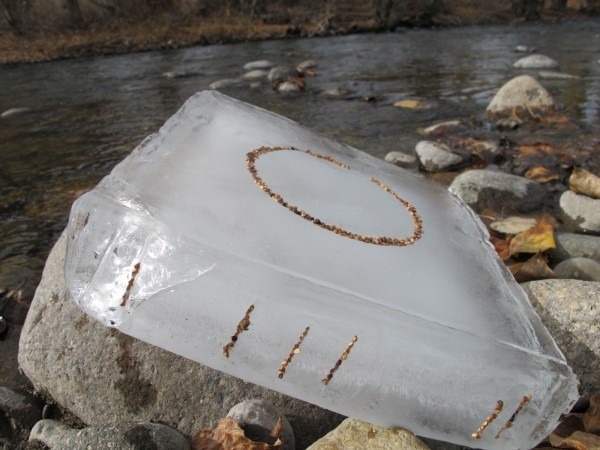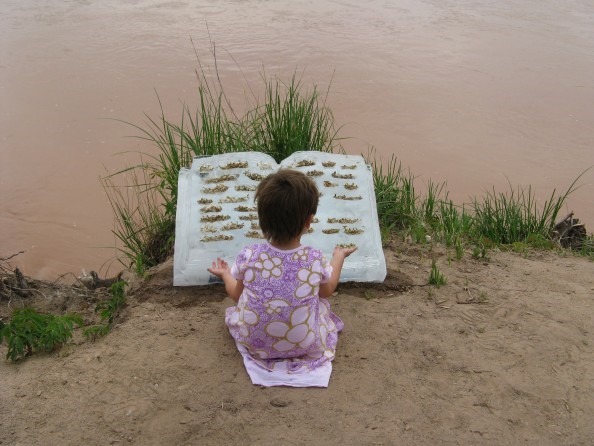This article was originally published by National Geographic’s Water Currents.
The original can be found here.
Basia Irland is a sculptor, poet, and installation artist who has focused her creativity on rivers for thirty years. Her aim is to connect people to their local waters and watersheds in ways that will motivate concern, caring, appreciation, and stewardship.
I first met Basia more than a decade ago when I was invited to speak at the University of New Mexico in Albuquerque, where today she is professor emerita. What I remember most from that first meeting was how her artistic thinking and work crossed just about every discipline present on the campus.
Water, Basia shows, is the great connector and integrator. The creative impulses infused into her sculpture and community projects – including the Ice Receding/Books Reseeding project she describes here – transform art into civic engagement with the Earth and inspire action to save the planet’s rivers.
–Sandra Postel Director, Global Water Policy Project
Text Below by Basia Irland, all photos courtesy of Basia Irland
In 2007 I carved a 250-pound sculptural “book” out of a huge block of frozen river water near the Arapaho Glacier, an important source of drinking water for the city of Boulder, Colorado. I engraved the ice book with “text” comprised of seeds from mountain maple (Acer spicatum), columbine flowers (Aquilegia coerulea), and Colorado blue spruce (Picea pungens), all native to the riverside habitats of the region. Four people carried the heavy book into the current of Boulder Creek and laid it between two large rocks. As the ice book began to melt, the seeds would disperse into the river and flow downstream.
Thus was born my project Ice Receding/Books Reseeding, an effort to draw attention to climate disruption and glacial melting, and to connect communities to their local rivers and the importance of their watersheds.
For the people of Boulder, the question was: when the Arapaho Glacier melts away, to what source will they – and local fish and wildlife – turn for their water?
Ice Receding/Books Reseeding represents a shift away from art as commodity and toward new creative possibilities of art in service to communities and ecosystems. It emphasizes the necessity of communal effort, scientific knowledge, and poetic intervention to deal with the complex issues of climate disruption and watershed restoration. Through the release of seed-laden ephemeral ice sculptures into rivers, creeks, and streams, the project not only connects people to their watersheds, it attempts to repair these watersheds by re-vegetating riparian (river-side) areas with native plants and trees.
Each “book launch” is an energized gathering of community participants, many of whom have not physically been to their river before the event. The project provides a hands-on educational experience by encouraging interaction with the river and demonstrating how specific native riparian seeds can help restore a watershed. Seed packets are gifted to the participants so they can continue the planting process.
Each project begins by carving frozen river water into the form of a book. Some books are large and weigh as much as 250 pounds; others are the size of a pocket book. Each is then embedded with an “ecological language” or “riparian text” consisting of local native seeds. The book is then placed back into the stream.
Closed books have seed patterns on the covers, while open books have rows of seeds forming sentences and paragraphs. These seeds are released as the ice melts in the current. Where the seeds choose to plant themselves is serendipitous, replicating the way seeds get planted in nature.

In future book launches, we plan to attach a probe to monitor temperature, light, and dissolved oxygen, as well as a micro-cam to gather data about where the current takes the seeds and how they get deposited along the banks. A GPS will also be installed to pinpoint locations.
On each project, I work with stream ecologists, river restoration biologists, and botanists to ascertain the best seeds for each specific riparian zone. When the plants regenerate and grow along the riverbank, they help sequester carbon, slow erosion, build the soil, filter pollutants and debris, and provide shelter and habitat for riverside organisms.
The variety of participants in an ice book launch depends on the location. Along the Nisqually River in Washington State, for example, participants included Nisqually Tribal Members, salmon restoration specialists, musicians, fifth graders from the WaHeLut Indian School, students and professors from Evergreen State College, and forest rangers.
Participants on the Rio Grande in New Mexico have included artists, farmers, acequia majordomos (irrigation ditch bosses), hydrologists, Pueblo members, and hundreds of interested watershed citizens.
Several months ago, two Ohio academic institutions, the University of Dayton and Antioch College, invited me to create a series of ice books with the involvement of the local communities. My residency was supported by Antioch College and the University of Dayton’s Departments of English and Visual Arts; College of Arts and Sciences; Rivers Institute; ArtStreet; Environmental Education Center; Arts Series; SEE (Sustainability, Energy, and Environment) Initiative; and the Women’s Center. The University of Dayton’s Rivers Institute enlisted a fleet of kayaks from which the books were launched into the Great Miami River.
With supporters and collaborators, I have launched ice books into rivers in Belgium, France, Italy, Spain, and across the United States and Canada. Riparian seeds have been released into spring-borne streams in Missouri, languid creeks in North Carolina, and rust-red acid mine drainage in West Virginia’s Deckers Creek. I have documented many of these launchings in my video, Ice Receding/Books Reseeding, which I began producing in 2007 and continue to update as new projects develop.
The ice books can be read as a universal invocation of and for the Earth. The tongues of the glaciers are receding, the voices of our rivers are being dammed and clogged with toxic debris. We need many diverse scribes writing about our rivers, and both real and virtual libraries to house their stories.

Basia Irland is an ecological artist, professor emerita at the University of New Mexico, and creator of the Ice Receding/Books Reseeding project. She has focused her art on rivers for the past thirty years. Irland’s work appeared in the March-April issue of Orion magazine and was highlighted in the September 2013 issue of Sculpture magazine. For more information, visit Irland’s website.
“Sandra Postel directs the independent Global Water Policy Project and lectures, writes, and consults on international water issues. She is also Freshwater Fellow of the National Geographic Society, and serves as lead water expert for the Society’s freshwater initiative. Sandra is the author of several acclaimed books, including the award-winning Last Oasis, the basis for a PBS documentary. Her essay “Troubled Waters” was selected for Best American Science and Nature Writing. Sandra is a Pew Scholar in Conservation and the Environment, and has been named one of the ‘Scientific American 50’ for her contributions to water policy” –National Geographic Voices.
This article was originally published by National Geographic’s Water Currents.
The original can be found here.
Basia Irland also writes creative essays from the perspective of the waterways she works with. In the coming weeks the MAHB will be sharing some examples of these inspiring essays.
This post is part of the MAHB’s Arts Community space –an open space for MAHB members to share, discuss, and connect with artwork processes and products pushing for change. Please visit the MAHB Arts Community to share and reflect on how art can promote critical changes in behavior and systems. Contact Erika with any questions or suggestions you have regarding the new space.
MAHB Blog: https://mahb.stanford.edu/creative-expressions/ice-books/
The views and opinions expressed through the MAHB Website are those of the contributing authors and do not necessarily reflect an official position of the MAHB. The MAHB aims to share a range of perspectives and welcomes the discussions that they prompt.
